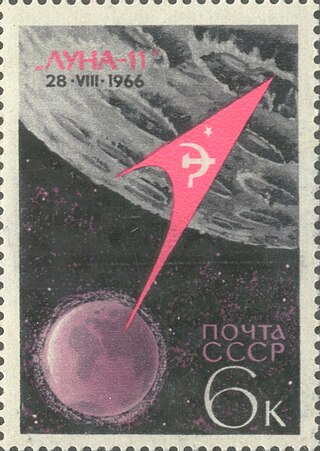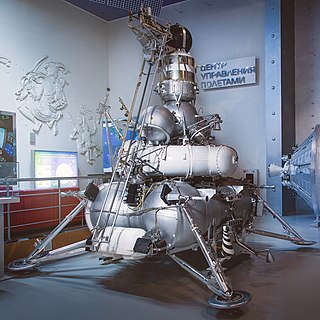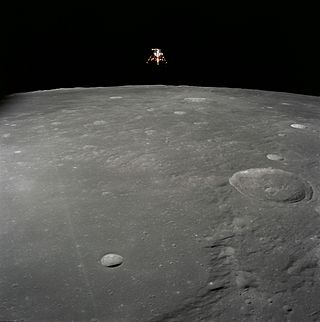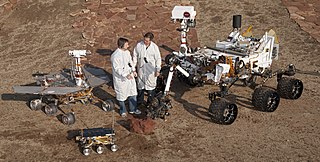
Lunokhod 2 was the second of two uncrewed lunar rovers that landed on the Moon by the Soviet Union as part of the Lunokhod programme.

The Luna programme, occasionally called Lunik by western media, was a series of robotic spacecraft missions sent to the Moon by the Soviet Union between 1959 and 1976. The programme accomplished many firsts in space exploration, including first flyby of the Moon, first impact of the Moon and first photos of the far side of the Moon. Each mission was designed as either an orbiter or lander. They also performed many experiments, studying the Moon's chemical composition, gravity, temperature, and radiation.
Luna 5, or E-6 No.10, was an uncrewed Soviet spacecraft intended to land on the Moon as part of the Luna programme. It was intended to become the first spacecraft to achieve a soft landing on the Moon, however its retrorockets failed, and the spacecraft impacted the lunar surface.

Luna 11 was an uncrewed space mission of the Soviet Union's Luna program. It was also called Lunik 11. Luna 11 was launched towards the Moon onboard a Molniya-M and entered lunar orbit on 27 August 1966.

Luna 15 was a robotic space mission of the Soviet Luna programme, that was in lunar orbit together with the Apollo 11 Command module Columbia.

Luna 16 was an uncrewed 1970 space mission, part of the Soviet Luna program. It was the first robotic probe to land on the Moon and return a sample of lunar soil to Earth. The 101 grams sample was returned from Mare Fecunditatis. It represented the first successful lunar sample return mission by the Soviet Union and was the third lunar sample return mission overall.

Luna 18, part of the Ye-8-5 series, was an uncrewed space mission of the Luna program.

Luna 20 was the second of three successful Soviet lunar sample return missions. It was flown as part of the Luna program as a robotic competitor to the six successful Apollo lunar sample return missions.

Luna 21 was an uncrewed space mission, and its spacecraft, of the Luna program, also called Lunik 21, in 1973. The spacecraft landed on the Moon and deployed the second Soviet lunar rover, Lunokhod 2. The primary objectives of the mission were to collect images of the lunar surface, examine ambient light levels to determine the feasibility of astronomical observations from the Moon, perform laser ranging experiments from Earth, observe solar X-rays, measure local magnetic fields, and study mechanical properties of the lunar surface material.

Luna 24 was a robotic probe of the Soviet Union's Luna programme. The 24th mission of the Luna series of spacecraft, the mission of the Luna 24 probe was the third Soviet mission to return lunar soil samples from the Moon. The probe landed in Mare Crisium. The mission returned 170.1 g (6.00 oz) of lunar samples to the Earth on 22 August 1976.

A lander is a spacecraft that descends towards, then comes to rest on the surface of an astronomical body other than Earth. In contrast to an impact probe, which makes a hard landing that damages or destroys the probe upon reaching the surface, a lander makes a soft landing after which the probe remains functional.

A Moon landing or lunar landing is the arrival of a spacecraft on the surface of the Moon, including both crewed and robotic missions. The first human-made object to touch the Moon was Luna 2 in 1959.

Luna E-8-5M No.412, also known as Luna Ye-8-5M No.412, and sometimes identified by NASA as Luna 1975A, was a Soviet spacecraft which was lost in a launch failure in 1975. It was a 5,300 kg (11,700 lb) Luna E-8-5M spacecraft, the second of three to be launched. It was intended to perform a soft landing on the Moon, collect a sample of lunar soil, and return it to the Earth.

A lunar lander or Moon lander is a spacecraft designed to land on the surface of the Moon. As of 2024, the Apollo Lunar Module is the only lunar lander to have ever been used in human spaceflight, completing six lunar landings from 1969 to 1972 during the United States' Apollo Program. Several robotic landers have reached the surface, and some have returned samples to Earth.

The physical exploration of the Moon began when Luna 2, a space probe launched by the Soviet Union, made a deliberate impact on the surface of the Moon on September 14, 1959. Prior to that the only available means of exploration had been observation from Earth. The invention of the optical telescope brought about the first leap in the quality of lunar observations. Galileo Galilei is generally credited as the first person to use a telescope for astronomical purposes; having made his own telescope in 1609, the mountains and craters on the lunar surface were among his first observations using it.

Third-party evidence for Apollo Moon landings is evidence, or analysis of evidence, about the Moon landings that does not come from either NASA or the U.S. government, or the Apollo Moon landing hoax theorists. This evidence provides independent confirmation of NASA's account of the six Apollo program Moon missions flown between 1969 and 1972.

A rover is a planetary surface exploration device designed to move over the rough surface of a planet or other planetary mass celestial bodies. Some rovers have been designed as land vehicles to transport members of a human spaceflight crew; others have been partially or fully autonomous robots. Rovers are typically created to land on another planet via a lander-style spacecraft, tasked to collect information about the terrain, and to take crust samples such as dust, soil, rocks, and even liquids. They are essential tools in space exploration.

The Lunar Reconnaissance Orbiter (LRO) is a NASA robotic spacecraft currently orbiting the Moon in an eccentric polar mapping orbit. Data collected by LRO have been described as essential for planning NASA's future human and robotic missions to the Moon. Its detailed mapping program is identifying safe landing sites, locating potential resources on the Moon, characterizing the radiation environment, and demonstrating new technologies.
















